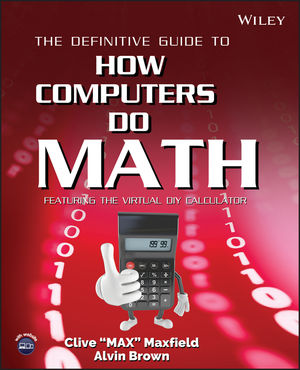The Definitive Guide to How Computers Do Math: Featuring the Virtual DIY CalculatorISBN: 978-0-471-73278-5
Paperback
464 pages
September 2005
 This is a Print-on-Demand title. It will be printed specifically to fill your order. Please allow an additional 10-15 days delivery time. The book is not returnable.
|
||||||
The Basics of Computer Arithmetic Made Enjoyable and
Accessible-with a Special Program Included for Hands-on
Learning
"The combination of this book and its associated virtual computer is fantastic! Experience over the last fifty years has shown me that there's only one way to truly understand how computers work; and that is to learn one computer and its instruction set-no matter how simple or primitive-from the ground up. Once you fully comprehend how that simple computer functions, you can easily extrapolate to more complex machines."
-Fred Hudson, retired engineer/scientist
"This book-along with the virtual DIY Calculator-is an incredibly useful teaching and learning tool. The interesting trivia nuggets keep you turning the pages to see what's next. Students will have so much fun reading the text and performing the labs that they won't even realize they are learning."
-Michael Haghighi, Chairperson of the Business and Computer Information Systems Division, Calhoun Community College, Alabama
"At last, a book that presents an innovative approach to the teaching of computer architecture. Written with authority and verve, witty, superbly illustrated, and enhanced with many laboratory exercises, this book is a must for students and teachers alike."
-Dr. Albert Koelmans, Lecturer in Computer Engineering, University of Newcastle upon Tyne, UK, and the 2003 recipient of the EASIT-Eng. Gold Award for Innovative Teaching in Computer Engineering
Packed with nuggets of information and tidbits of trivia, How Computers Do Math provides an incredibly fun and interesting introduction to the way in which computers perform their magic in general and math in particular. The accompanying CD-ROM contains a virtual computer/calculator called the DIY Calculator, and the book's step-by-step interactive laboratories guide you in the creation of a simple program to run on your DIY Calculator.
How Computers Do Math can be enjoyed by non-technical individuals; students of computer science, electronics engineering, and mathematics; and even practicing engineers. All of the illustrations and interactive laboratories featured in the book are provided on the CD-ROM for use by high school, college, and university educators as lecture notes and handouts.
"The combination of this book and its associated virtual computer is fantastic! Experience over the last fifty years has shown me that there's only one way to truly understand how computers work; and that is to learn one computer and its instruction set-no matter how simple or primitive-from the ground up. Once you fully comprehend how that simple computer functions, you can easily extrapolate to more complex machines."
-Fred Hudson, retired engineer/scientist
"This book-along with the virtual DIY Calculator-is an incredibly useful teaching and learning tool. The interesting trivia nuggets keep you turning the pages to see what's next. Students will have so much fun reading the text and performing the labs that they won't even realize they are learning."
-Michael Haghighi, Chairperson of the Business and Computer Information Systems Division, Calhoun Community College, Alabama
"At last, a book that presents an innovative approach to the teaching of computer architecture. Written with authority and verve, witty, superbly illustrated, and enhanced with many laboratory exercises, this book is a must for students and teachers alike."
-Dr. Albert Koelmans, Lecturer in Computer Engineering, University of Newcastle upon Tyne, UK, and the 2003 recipient of the EASIT-Eng. Gold Award for Innovative Teaching in Computer Engineering
Packed with nuggets of information and tidbits of trivia, How Computers Do Math provides an incredibly fun and interesting introduction to the way in which computers perform their magic in general and math in particular. The accompanying CD-ROM contains a virtual computer/calculator called the DIY Calculator, and the book's step-by-step interactive laboratories guide you in the creation of a simple program to run on your DIY Calculator.
How Computers Do Math can be enjoyed by non-technical individuals; students of computer science, electronics engineering, and mathematics; and even practicing engineers. All of the illustrations and interactive laboratories featured in the book are provided on the CD-ROM for use by high school, college, and university educators as lecture notes and handouts.
For online resources and more information please visit the author's website at www.DIYCalculator.com.



